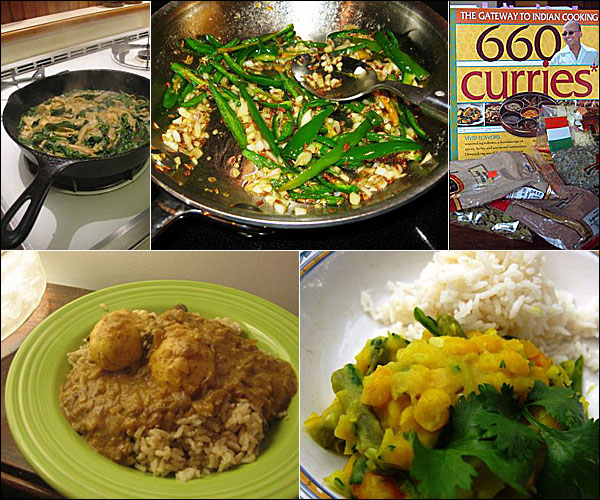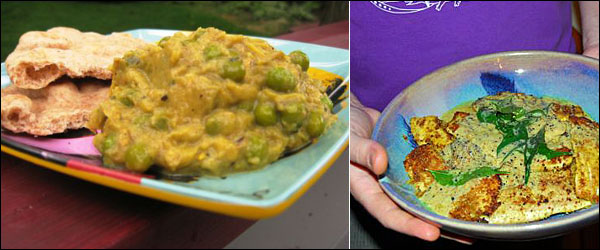
The scope of 660 Curries, Raghavan Iyer’s new cookbook, is intimidating. But recipe by recipe, the collection is accessible even to the inexperienced cook. In these dishes, all of the complexity lies in the spices, without which most would be considered rather minimalist.
In fact, it is the spices, from fresh curry leaves to black cardamom, that may cause a timid cook to pause at the Gateway to Indian Cooking, as the book proclaims curry. Luckily, the Twin Cities are well-equipped with Indian grocers. We found ourselves at Patel Groceries on Central Avenue, where the proprietors were extremely helpful and supportive, guiding us through both the store and the Hindi translation of spice names with patience.
“Wish us luck,” we said, as we trundled out of the grocery with our papads, kasoori methi, javentri, and fenugreek leaves.
“It’s easy,” said Faheem, “a little of this, a little of that… just sprinkle it on.”
“Hah!” said Shabana. “I’m going to ask him to cook for me.”
So that’s my advice: check out Patel Groceries.
Iyer, author of Betty Crocker’s Indian Home Cooking and The Turmeric Trail: Recipes from an Indian Childhood, also offers advice and tips for both novice and experienced cooks, but in hindsight two very basic but infinitely helpful points stand out: Read the recipe all the way through and prep all of your ingredients before you start cooking. All of the herbs and spices end up in the same place, but each tastes dramatically different depending on whether it went into the sauce ground, whole, toasted, or raw. And, one simply can’t go pawing through the spice drawer looking for black cardamom once the heat is on and your curry is bubbling away in an aromatic steam.

The recipe portion of 660 Curries ($22.95, 809 pages) opens with a short but interesting exploration of the origins — or lack thereof — of the word “curry,” which Iyer defines broadly as anything simmered in a sauce or gravy of herbs and spices. He also breaks down the elements of curry’s flavor: bitter, sour, salty, sweet, pungent, astringent, aromatic, and the elusive Japanese umami, defined here as the tongue-coating succulence that monosodium glutamate and the “free glutamate” found in dairy, meat, and fish bring to a dish, the flavor enhancing, tasty element.
In his recipes, Iyer attempts to balance these elements, and though we were not always in agreement on his success, it was interesting to pick them out as we sampled the dishes.

For example, a colleague found the Seasonal Vegetables with Yellow Split Peas to be heavy on the heat. The recipe called for six to eight Thai, cayenne, or serrano chiles plus the seeds. She used six serranos and, though Iyer warned, “Don’t be alarmed by the number of chiles…[The other ingredients] bring the heat level down to make each bit addictive without excess heat,” her dining companions could hardly eat the dish, and all professed to like a mild to medium amount of spice. She wrote: “If we added half the serranos, this would have been a very enjoyable dish. The ‘Tips’ section was helpful (for example, it suggested we could substitute cornstarch for chickpea flour) and the directions were descriptive.”
She also tried the Grilled Eggplant with Peas and Butter. She writes: “Preparing the eggplants by broiling, mashing, and cooking them on the stovetop wasn’t something I’d think of, but it worked well, was easy, and tasted great.”
The curry was sweet, thanks to the heavy cream and golden raisins, which balanced the slightly bitter eggplant well, and the peas added some much-needed texture. It’s a dish that could pair nicely with a bold, spicy meat curry. “This recipe called for four Thai, cayenne, or serrano chiles,” she added. “Due to the first recipe we were quite gun-shy about the chiles and opted for two with no seeds, which made for a fairly mild dish. But overall, this was definitely a dish we’d make again.”

Also on the less piquant but lovely side was the Spiced Lamb Chops with Fenugreek Sauce. We had enjoyed these at the opening of OM Contemporary Cuisine, so the opportunity to cook them proved irresistible. The sauce is a combination of dried fenugreek leaves, saffron cream, and Kashmiri garam masala, an aromatic blend that includes cumin, cinnamon, nutmeg, black cardamom, cloves, ginger, fennel, pepper, and mace. In the pan, all those spices eluded us, lost in what seemed a bit too much salt, but on the lamb — marinaded in a similar spice blend and seared — the salt balanced out, becoming subtly sweet, ever so bitter, and very tasty.
So focused on getting the lamb to the table were we that an ingredient was left out of the Yellow Split Pea Soup, which could be categorized as a dal. This one included red onion, ginger, and fresh thai peppers tempered by cream for a pleasantly warming kick. It was easy on the palate, but something did seem missing, we thought… something green — the fresh cilantro! Once we tossed it on, the soup acquired a surprising sweetness. Overall, this recipe will be a keeper for the fall months.
Not so the Hard-Cooked Eggs in Coconut Curry. Red onions and coconut milk combined to make the sauce deliciously sweet and, in it, the egg functioned much like a potato. Unlike that most excellent of tubers, however, the egg failed to absorb any of the curry’s spice — in this case, dominantly cinnamon. We enjoyed it, but without great enthusiasm. We might try it again with potato, but then again, with 659 other recipes to work through…
A dish of Chopped Spinach with Dried Lentil Wafers (papad) received mixed reviews. In it, fresh spinach is steamed in a curry bath that includes mustard seeds (which bounce out of the pan like popcorn when you toast them), paprika, Thai chiles, and fresh curry leaves. Oddly enough, the latter smell a bit like tar until toasted, when they stink of something disconcertingly like burning rubber yet seemed to meld right in with the other flavors once cooked.
The papad are tossed in with the spinach, to become soggy, limpid, bits of salty lentil wafer, which some of us thought spoiled an otherwise interesting spinach dish — hot and redolent of mustard — and others found compelling.
Universally, the favorite dish was Breaded Tilapia with Mustard Seed Coconut Milk. In this recipe, the tilapia is sopped in lime juice and the Roasted Curry Leaf Spice Blend — a fairly pungent blend that includes lots of Thai chiles and some very nutty, toasted yellow pigeon peas — dredged through panko crumbs, fried, and covered in a fragrant coconut milk sauce and a pile of curry leaves. The end result was a worthwhile fish dish; delicate and succulent, its flavors married so completely one could not separate them.
So, as a reviewer, here is the conundrum: Over the course of recipe testing, nearly every review was fairly positive and several overwhelmingly so; still time and again, not unlike our visit to OM, comparisons were made to local Indian restaurant Gandhi Mahal. Cooking Iyer’s recipes, the whole house is filled with an incredibly dense and aromatic curry fog, but that doesn’t always play out in the flavor of the food. What we miss in 660 Curries is the depth of spice one finds at Gandhi Mahal — curries that are at complex, rich, and yet very light at the same time. One diner went so far as to say of the tilapia: “It’s really good, but not exciting.”
That said, this is not only a comprehensive work but the result of quest, in Iyer’s own words, that took the author across India, knocking on doors and wading through hundreds of books. One wonders: Are we simply unaccustomed to this side of the spectrum, the lighter, more subtle, and in some cases, contemporary side of Indian food? Maybe as diners and home cooks, our task is to enjoy it as something new, without comparison.
The jury is still out. In the meantime, we will continue to plow our way through 660 Curries, an effort that is surely not without its rewards.
Patel Groceries
1835 Central Avenue NE
Minneapolis, MN 55418
612.789.8800
Emily Nystrom contributed recipe testing and reporting on the Seasonal Vegetables and on the Grilled Eggplant. Thank you!

One of the challenges I have found with making Indian food at home is that my points of reference—Indian restaurants like Gandhi Mahal—serve a cuisine that was developed in Indian restaurants in England (based mostly on north Indian dishes). When I started trying to make my own Indian food (using Maya Kaimal MacMillan’s Curried Favors, which I recommend) I found the mostly south-Indian dishes unfamiliar and a bit disappointing compared to the sweet, creamy things coming out of restaurants (I came to appreciate them in the end).
If Iyer has built his cookbook by doing field work in India, many of his curries would be pretty unlike the food at Gandhi Mahal (disclaimer: I’ve never been to Gandhi Mahal, but I did check out their menu); they are frankly different cuisines. I think the problem is that writing a book on Indian Cuisine is like writing a book on “European Cuisine”; there are a lot of regional variations being painted over with a broad brush. But from a marketing standpoint, most people in this country are familiar with “Indian” rather than the various states and regions of India, so the idea of Indian cuisine is what we’re stuck with.
Tom, most Indian restaurants outside of India serve you food that is nowhere close to authentic. Its sad how they dish out food which is more suitable to the American palate. The best way to actually taste good Indian food would be to get yourself invited over for dinner to an Indian friend’s place and while you are there coax a recipe or two you can try back home!